What does it mean to be Hispanic?
Photos by Forrest Anderson
The words Latino and Hispanics are common catchall terms for a large segment of the U.S. population. I decided to go in search of what the two words really mean. Little did I know that there seems to be no universal definition for them.
What both terms clearly are not are references to a specific race. Latinos and Hispanics identify themselves on the U.S. census as white, biracial or multi-racial, African, Asian, or Native American. Since Pacific Islanders live on Easter Island and it belongs to Chile, any descendants of them living in the United States also could be considered Latinos.
The majority of people who identify as Hispanic or Lationo prefer to be called Hispanic, and a quarter prefer to simply be called Americans. Others prefer to use their ancestors' specific country of origin instead.
The terms Hispanic and Latino are fraught with political and colonial origins and connotations that, while the terms are widely accepted, are problematic for some people. Even the U.S. government can’t agree on what the two words mean.
The U.S. Census bureau, which collects data from U.S. residents every ten years on ethnicity and race, started using the term Hispanic in 1970. In 1997, it officially replaced the term Hispanic with Latino, to describe U.S. residents who speak Spanish and live in a household where Spanish is spoken, have Spanish heritage because of the location where they or their ancestors were born, and identify their ethnicity with Latin America, excepting Brazil.
Other federal departments and non-profit organizations include Brazilians and Portuguese in their definition of Hispanics. The U.S. Office of Management and Budget defines Hispanics and Latinos as U.S. residents who trace their descent to Mexico, the Dominican Republic, Puerto Rico, Cuba, Central and South America except Guyana, French Guiana and Suriname, and other Spanish cultures. Presumably, this could include the Philippines and Spain.
The U.S. Department of Transportation defines Hispanic as, "persons of Mexican, Puerto Rican, Cuban, Dominican, Central or South American, or other Spanish or Portuguese culture or origin, regardless of race." The Small Business Administration and some other government agencies use this definition to grant government contracts to minority-owned businesses. The Congressional Hispanic Caucus and Congressional Hispanic Conference include representatives of Spanish, Portuguese, Puerto Rican and Mexican descent. Any person who traces his or her origins to the Spanish or Portuguese empires can identify as Hispanic for work purposes, the U.S. Department of Labor says.
The terms Latino and Hispanic are not synonymous. Latino is used mainly in the United States and is a short version of the Spanish word latinoamericano. It most commonly is used to refer to U.S. residents who are descended from Latin Americans.
The word Hispanic, on the other hand, generally is understood to include those descended from Spaniards and others who speak the Spanish language, a much wider demographic. Outside the United States, people are more commonly referred to as having ancestry from specific countries – Colombians, Mexicans, for example.
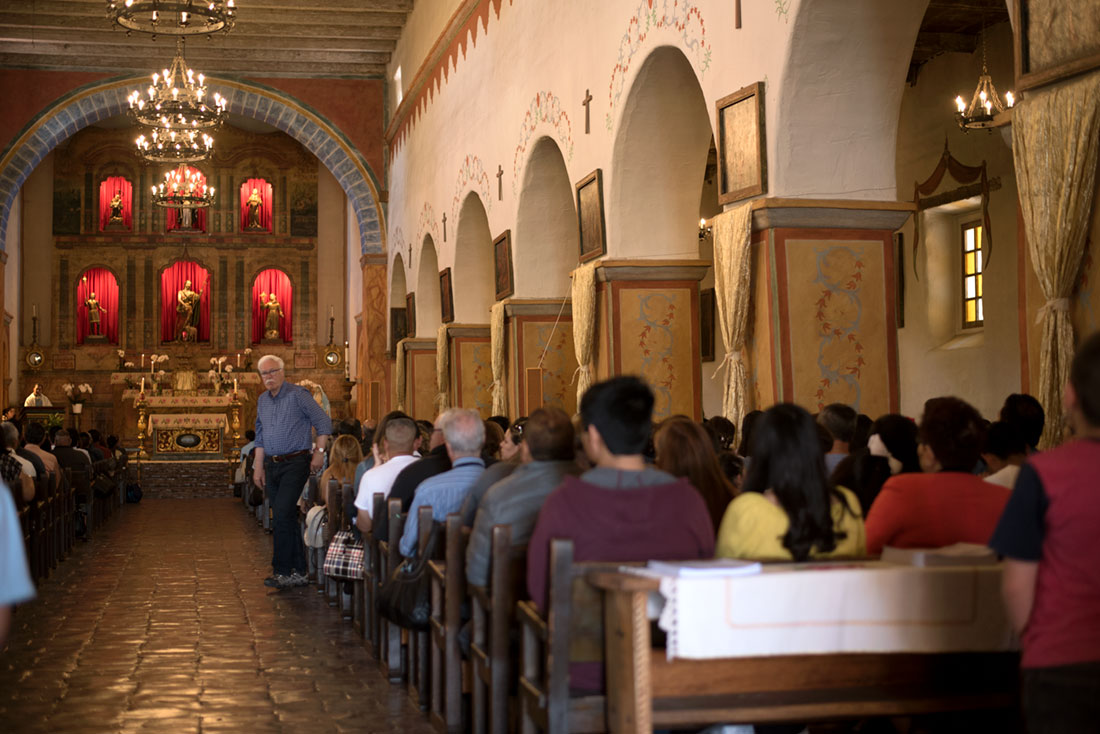
Above, a Spanish-speaking mass on the weekend of Cinco De Mayo at the San Juan Bautista Mission in California. Among residents of the area are descendants of people who lived there at the time it was ruled by Spain and then Mexico. Others have families that immigrated more recently to the United States.
In the media, the generally accepted usage as defined in the Associated Press Stylebook is the word Latino for people whose ancestors are from Latin America, regardless of the language they speak, so the term also would include all people from the Caribbean as well as former Dutch, French and British colonies.
The term Latin America from which “Latino” is derived has an equally ambiguous historical origin and meaning. It actually was coined by the French in the 1830s. Their motive was colonial, since as Spanish power faded in the region, France tried to extend further into the Americas. The term Latin America was intended to create a French rationale for intervening in the region, a notion that France was part of Latin Europe and the Latin-influenced Americas ought to be allied with Latin Europe rather than with Britain or Germany. The French thus created the notion of a Latin ethnicity that encompassed the area from Mexico to the southern tip of South America. Napoleon III, who unsuccessfully tried to extend French power into Mexico in the 1860s, used the term Latin America to emphasize the shared Latin background of France, Spain and Portugal.
South American and U.S. politicians adopted the term and gave it another connotation - opposition to extension of U.S. influence south of the U.S. border, including the 1846-48 Mexican-American War in which Mexico lost a third of its territory to the United States.
Many scholars and political activists dislike the term Latin America, claiming it is colonial and has no basis in reality because the region is so diverse and is not governed by any umbrella organization.
So what about the term Hispanic? Its history is even fuzzier. The word Hispania comes from a now extinct language spoken by Celts who once lived in an area on the Iberian Peninsula. The ancient Romans picked it up and used it to describe the Iberian Peninsula and Gibralter, which were then under Roman rule. During the Roman Empire, the term included Roman colonists in Hispania, among them several Roman emperors whose families colonized Hispania. Marcus Aurelius, Trajan and Hadrian were considered from HIspania. The Spanish later used the word Hispania and the British adopted it in the 16th century.
It has always been problematic partly because the peoples on the Iberian Peninsula already were a mix of many cultures and tribes, some of which don’t speak Spanish and have origins in locations on the European, Middle Eastern and African sides of the Mediterranean Sea.
When the Spanish later conquered areas of the Americas, Africa and Asia, they freely intermixed with indigenous peoples to create a population of truly global ancestry. In the Americas, that ancestry is called Hispanic, but the term isn’t universal. In Portugal, Hispanic means anything related to ancient Hispania or Spain. In Spain, the definition is anything relating to old Hispania, a Spanish person, a Hispanic American, and people in the Philippines. The term hispanoamericano in Spain refers to people of Spanish origin living in the Americas, but not to native Americans in areas once dominated by the Spanish.
It wasn’t until the 19th century that North Americans started to use the word Hispanic to describe Spanish speaking people from anywhere.
The genetic mix of various countries in Latin America varies widely. Sixty-five percent of the population of Mexico is a combination of European and native American called mestizo, and most of the rest are either European Native American. Costa Rica, on the other hand, is 81 percent white, while El Salvador is 86 percent mestizo. Argentina is 86 percent Spanish and Italian and just 14 percent non-European. Uruguay, 88 percent white, has less than .5 percent native American population. Puerto Rico has only a small percentage of Asians and native Americans, and the rest are Caucasian and of African descent, while Equatorial Guinea is mostly native American.
The Spanish also were heavily involved in the Western Sahara and Spanish is widely spoken there, although Arabic is the official language. The culture of the Philippines, once a Spanish colony, has been heavily influenced by the entry of Spanish words into native languages, the dominant Catholic religion and Spanish cuisine, dance, music, festivals and architecture. The Asian culture of the Philippines, in turn, significantly affected Latin America as Asian trade flowed through Manila to the Americas. The Mexican national costume is believed to have derived from silk skirts from China, and the Mexican majolica ceramics from Chinese porcelain imported to Mexico through Manila.

Bright colored Mexican majolica ceramics were heavily influenced by Chinese porcelain imported through Manila to Mexico.
The term Iberian is commonly used instead of Hispanic to refer to Portuguese and Spanish cultures. For example, if your DNA test shows that, like mine, you have ancestors from the Iberian Peninsula, you are considered part or all Iberian. American cultural influences that were derived from Spanish and Portuguese culture also are sometimes referred to as Iberian American.
So are the terms Hispanic and Latino useful? From a cultural standpoint within the United States, they are because they help identify, even if very imprecisely, a general genre of music, cuisine, media, businesses, festivals and holidays that are pervasive in the United States. They also describe a significant part of the history of the United States.
Spanish-speaking peoples have lived within the territory now encompassed by the United States for 400 years, and the Spanish history of some of the largest states is a dominant influence on the culture in those areas - California, Texas, Colorado, New Mexico, Arizona, Nevada, Florida and Puerto Rico. These areas once were part of New Spain and the first six states were part of Mexico before 1848. Many of the most important U.S. cities were founded by the Spanish in the 1500s, 1600s or 1700s - St. Augustine, Florida; Santa Fe and Albuquerque, New Mexico; El Paso and Laredo, Texas; San Diego, San Francisco, San Jose, and Los Angeles, California to name only a few.
In the American Southwest, New Mexican Hispanos, Pueblo Indians, Genizaros, Tejanos, Californios and Mission Indians were the major groups who were part of colonial Spain. Most of them eventually adopted English as their first language. In 1848, these groups became U.S. citizens via the treaty that ended the Mexican-American War. Although they were classified as of the white race in the treaty, they continued to face racial discrimination. Indigenous Mexican Americans were not granted U.S. citizenship until the 1920s. Because of discrimination, many who had indigenous blood claimed Mexican American or Spanish ancestry and obscured their indigenous roots. For some of their descendants who have had their DNA tested and found that they have largely indigenous genes, this has sparked somewhat of an identity crisis. Born and raised to love Latino culture, they are confronting the Spanish oppression of their ancestors for the first time.

A statue at a Roman Catholic Church in Taos, New Mexico.
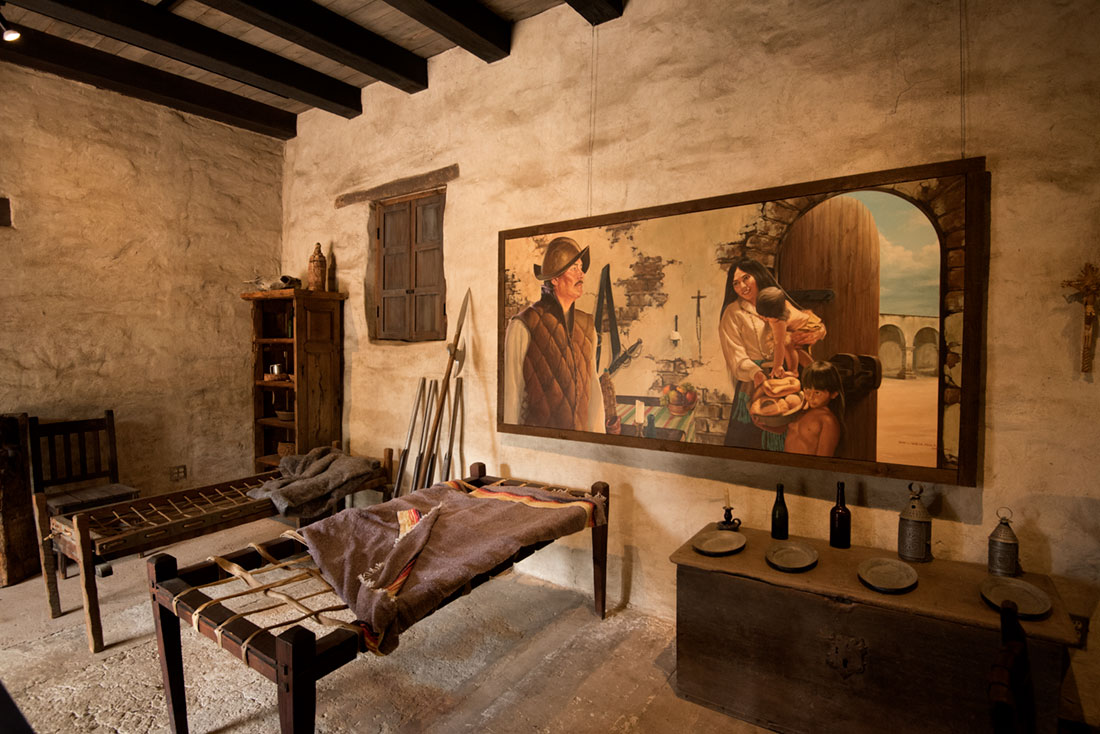
A painting in the San Juan Capistrano Mission depicts a Spanich soldier and a Native American woman at the mission. Spanish priests who built missions were accompanied by troops who subdued Native Americans who resisted them.
Foremost among the objections to the terms Latino and Hispanic are that they obscure the long native history of the region. South America is believed to have been settled as long ago as 14,000 years, and to have been home to tens of millions of people and empires such as the Toltecs, Mayans, Inca and Aztecs. The indigenous inhabitants of Latin America were part of diverse kingdoms and tribes. When they intermixed with the colonists from the equally diverse Iberian Peninsula, Latin America became one of the most multicultural regions of the world.

A cemetery on the Pueblo indian reservaion in New Mexico that dates back to the Spanish occupation of the area.
The Spanish brought European diseases that historians believe killed 25-85 percent of the native population. Many others died of forced labor. The colonizers intermixed so thoroughly with the remaining native peoples that in many colonies, people of mixed ancestry became the majorities. African slaves also were forced to the Americas and intermixed with the native people.
Most Latinos in the United States today are descendants of immigrants who entered the United States since World War II. Immigration from Mexico increased greatly in the 1980s, 1990s and 2000s. It is a myth that the majority of Spanish-speaking immigrants and their children don’t speak English. At least three-quarters speak English well.
Among the common rationales supporting the term Latino is the Roman Catholic Church's strong identification with the Latino/Hispanic community. Roman Catholicism, aggressively spread by Catholic priests in the Americas and Philippines, is the predominant religion in Latin America and about 65 percent of Hispanics in the United States are Catholic. The influence of Latin America on the Roman Catholic Church is conversely so extensive that it is considered the stronghold of the church's membership.
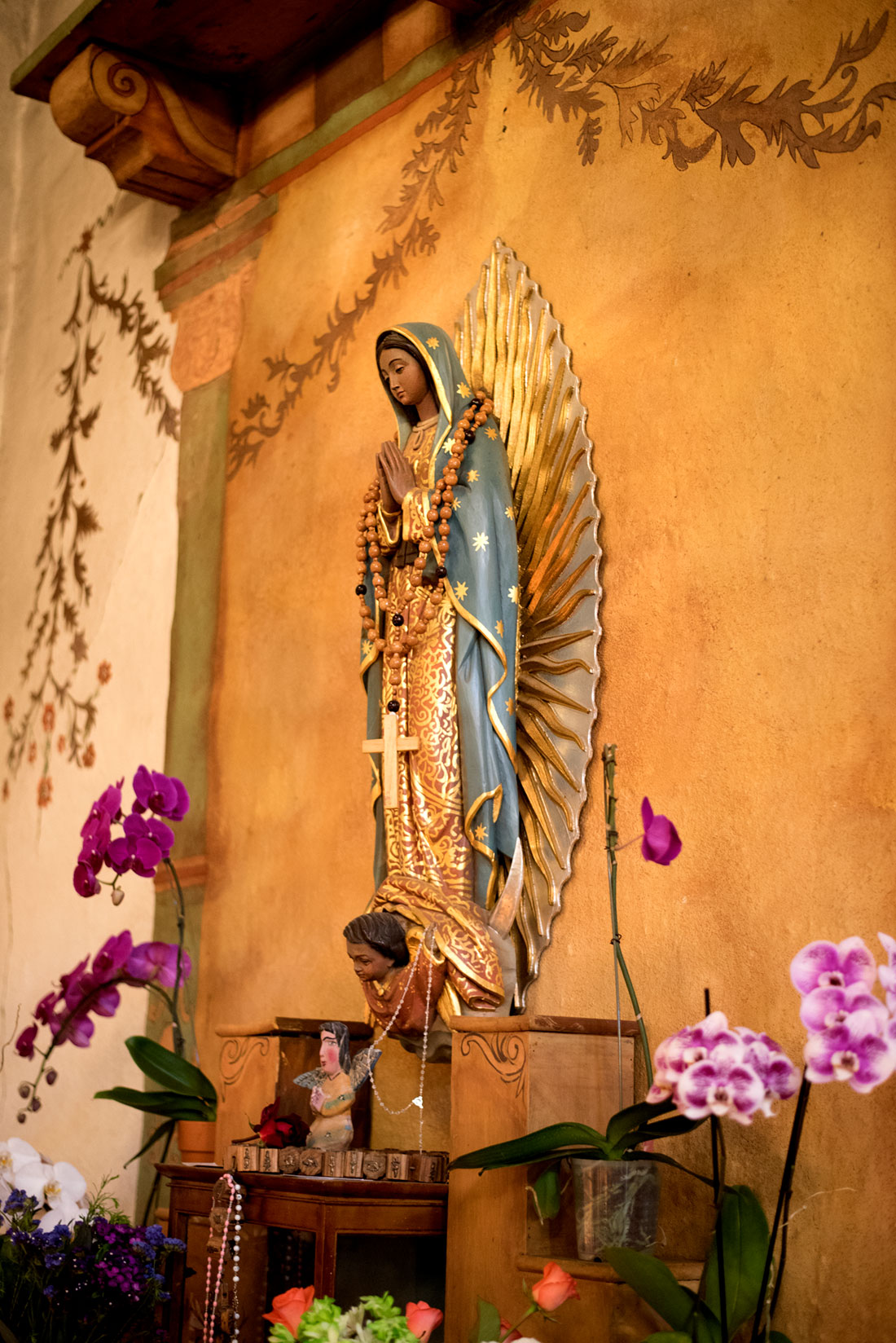
Above, a statue of a Native American Virgin Mary at the San Juan Bautista, California, mission.
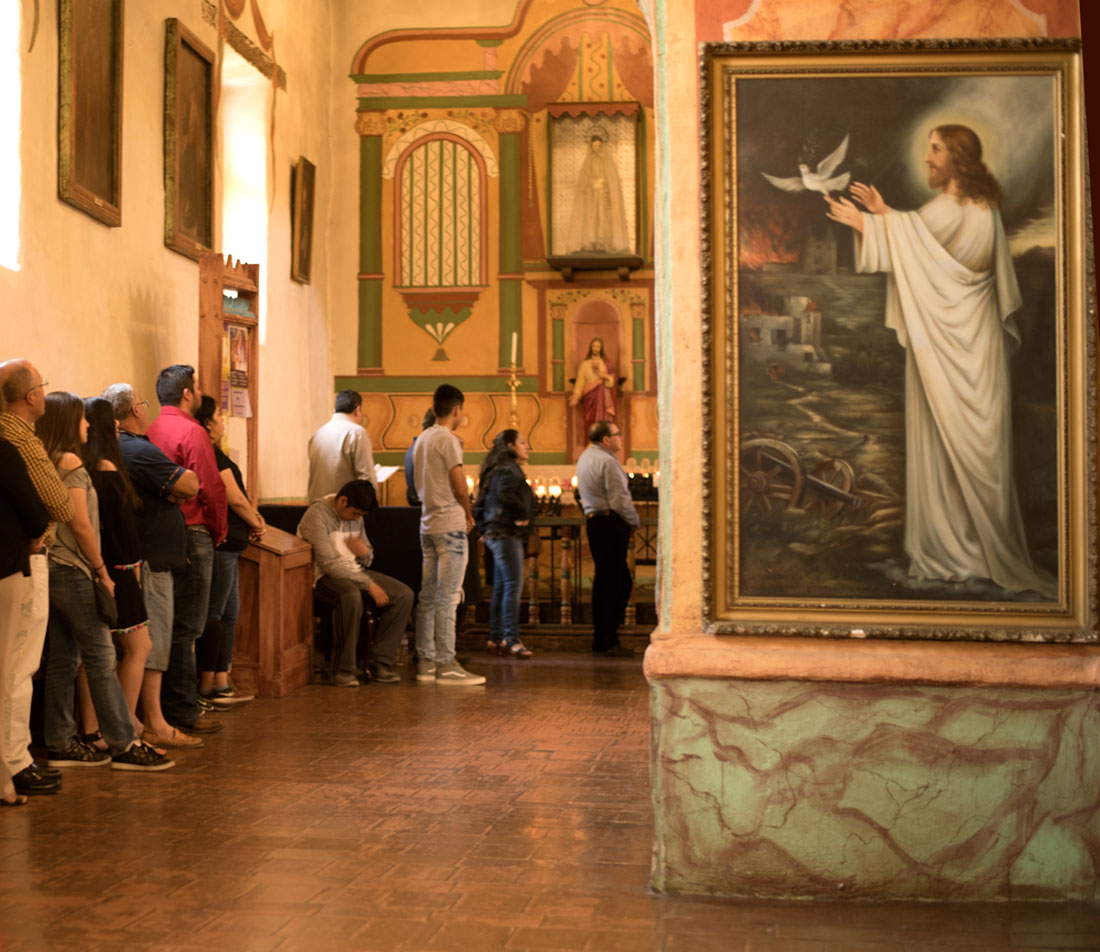
Standing room only at a Spanish-speaking mass at San Juan Bautista.
Another rationale for the term Latino is the shared Spanish language, although Latin America actually has many languages. The region's linguistic make up is the result of an arbitrary agreement by Portugal and Spain that Spain would take the lands to the west and Portugal to the east, where Brazil is today. France also occupied parts of the Americas and imposed French customs, government and language on the native population. About 60 percent of Latin America speaks Spanish and 34 percent Portuguese. Other languages spoken in various parts of the region are numerous native languages, English, French, Dutch, Italian, Russian, German, Hebrew, Japanese, Chinese and Korean. Languages also are spoken that are a mix of languages, such as Haitian Creole which is derived from French, West African languages, native, Portuguese and Spanish.
Latin American Spanish varies widely from country to country. Many of the most common Spanish words used in the United States, such as taco and tamale, are native American words that entered the Spanish language.
About eleven percent of the population of the United States, or 36.3 million people, are of Mexican ancestry, and Mexican Americans are 63 percent of all Hispanics and Latinos in the United States. More than 60 percent of Mexican Americans live in California and Texas. This ethnic group is more than a fourth of the entire Mexican population of the world. Thus, Latino culture in the United States is heavily weighed toward Mexican culture.
Latin American art, food and music are strongly influenced by indigenous cultures, Spanish, Portuguese, French, African, Chinese and other cultures. The combination makes Latin American one of the world’s most culturally interesting regions. Latin pop, hip hop, rock and other forms of music are popular globally and have mixed with other American types of music to create uniquely Latino genres that continue to evolve.

Latino musicians performing in Los Angeles.
A snippet of music at a Latino concert in Taos, New Mexico. Such concerts are a popular part of the U.S. music scene.
In art, influences as diverse as African folk art blend with traces of the Italian masters that reached the Americas through Spain. Latino culture has also inspired its own forms of architecture that combine folk art decoration with European influences, some of which themselves derive from Arabic architecture.

This modern church, built to replace the historic church at San Juan Capistrano Mission in California, which was destroyed by an earthquake, combines a European structure with the handpainted motifs common in Mexican churches. Spanish-influenced architecture is one of the most popular forms in the United States today.
In cuisine, Latino chefs are aggressively combining Mexican and Southwest cuisine, one of the United States' most popular food traditions, with Asian influences to create popular new fusion foods.
Speaking of fusion, that's the bottom line of this blog entry. Latino and Hispanic cultures are the ultimate fusian cultures - in the best tradition of the American melting pot. A precise definition of Latino and Hispanic thus is unlikely ever to be set in stone, as the most salient cultural characteristic of the Latino/Hispanic culture is a continuing adaptation and blending of a variety of cultures in ever more vibrant and creative ways.
Related photos:
Check out these related items

Fruit Drinks of Mexico and Asia
Delicious fruit drinks are ubiquitous at restaurants and street stands in Mexico, Taiwan and Southeast Asia. You can make them at home with our favorite recipes.
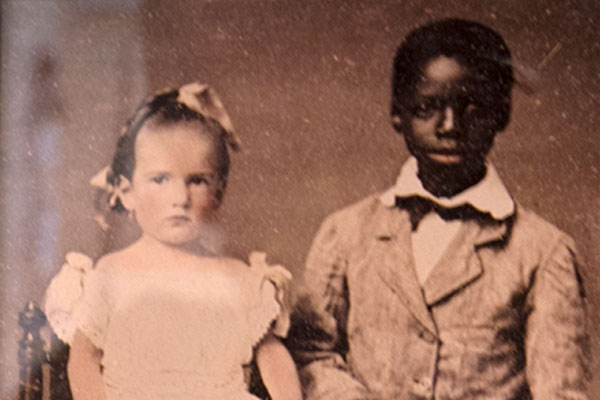
The History of Race in America
The racial history of the United States belongs to us all, with the responsibility to resolve the accompanying outstanding problems.
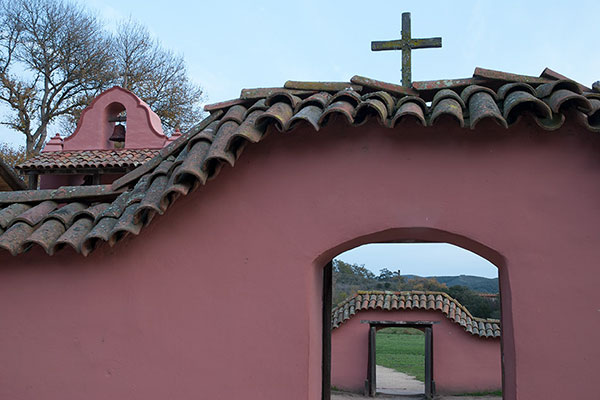
The Land of Junipero Serra
Junipero Serra's "sainthood" is controversial, but the extent of his cultural impact on California is indisputable.
